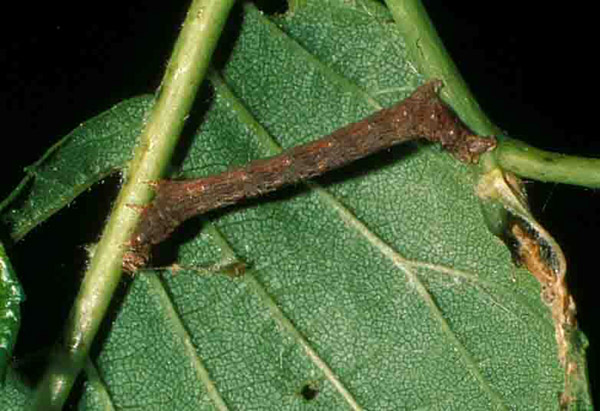Issue 1, April 17, 2009
Cankerworms
Spring and fall cankerworms are feeding at this time throughout Illinois. Their primary host is American elm, but they also feed on other elms, hackberry, crabapple, honey locust, and other trees. Heavily attacked trees appear to be slow in leafing out. Closer inspection reveals that the leaves are being eaten as they emerge.
Before American elm was decimated by Dutch elm disease, cankerworm populations periodically became very large in Illinois, removing all of the early spring foliage which resulted in bare trees into June. Since then, this insect has been much less numerous.
The caterpillars are green, brown, or mottled green and brown. Cankerworm larvae are called loopers, or inchworms, because they form their bodies into loops as they move. Spring cankerworm caterpillars have only two pairs of prolegs, located at the posterior end of the abdomen; fall cankerworm caterpillars have two pairs of prolegs and a partial third pair.

While most caterpillars wriggle as they crawl with their three pairs of true legs and five pairs of prolegs, it is more efficient for cankerworms to loop. The larva extends its body out and grabs onto the leaf or twig with its three pairs of true legs located just behind the head. The posterior prolegs then let go and move forward to grab onto the leaf or twig just behind the true legs. In the process, the long, thin abdomen forms a loop. The prolegs then hang on while the true legs release and the caterpillar extends forward.
After feeding through the spring, the mature cankerworms drop to the ground on strands of silk. Pupation occurs in the soil. Adult fall cankerworms emerge in the fall, being the last moths of fall. Males have brown wings and a wingspan of about one inch. Females are wingless and crawl up the tree to lay her eggs. Adult spring cankerworms are similar in appearance to fall cankerworms, but emerge in late winter. They are the earliest moths of spring. Both species’ eggs hatch in the spring at bud break.
In the past, bands of Tanglefoot, Tack-Trap, or other sticky substances were applied as bands around the tree trunks to catch ascending females. This effectively eliminated caterpillar feeding. Unfortunately, these substances reduce the diameter growth of the tree. Over several years, the banded area became the narrowest area of the trunk. If this method is used, the corky outer bark is shaved away with a drawknife or other tool and then a band of kraft or other heavy paper is put around the trunk. The sticky substance is then applied to the outside of the paper. This keeps the sticky substances from contacting the tree.
Scout for cankerworms by sharply striking the branch. Many of the cankerworm larvae will be dislodged from the foliage and hang on several-inch-long silk threads. If caterpillar numbers are high, a spray of Bacillus thuringiensis kurstaki, sold as Dipel, Thuricide, and other brand names, should provide control. There are other labeled, effective insecticides, but avoid applying them to trees in bloom to protect honey bees and other pollinating insects.--Phil Nixon
Author:
Phil Nixon